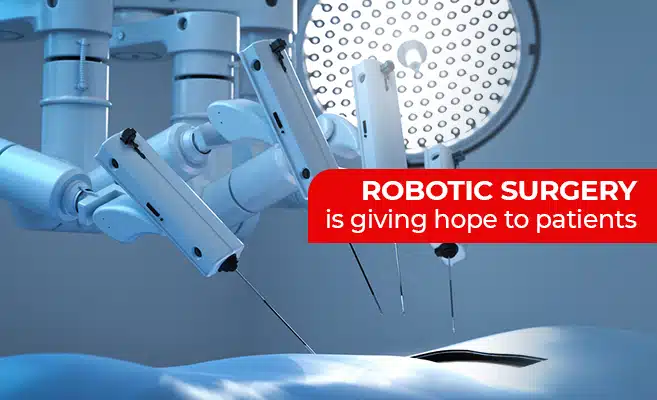What Is Robotic Surgery And Its Benefits

Robotic Surgery is becoming the path for medical science to help patients with serious ailments. It’s a noble transition, and people have become hopeful that their surgeries are being conducted with precision.
Robotic surgery is a type of minimally invasive surgery during which doctors use some small surgical instruments that fit into a patient’s body through a series of tiny incisions. Robotic surgery in India offers multiple benefits to patients as compared to open surgery.
What is Robotic Surgery?
Robotic surgery, also known as robot-assisted surgery, allows healthcare providers to perform different types of complex procedures with more flexibility, precision, and control than conventional techniques. Robotic surgeries are usually associated with minimally invasive surgery. It is also sometimes used in some traditional open surgical procedures.
The most widely used clinical robotic surgical system includes a camera arm and mechanical arms with surgical instruments attached to them. The technology consists of the following:
- Surgical arms with tiny tools with wrists at the tip.
- A special camera that offers an enhanced magnified 3D view of the surgical area.
- Surgical console where the surgeon controls all the movement of the instrument and camera.
How Does the Robotic Surgical System Work?
To operate using robotic surgery in India, the surgeon makes tiny incisions in the patient’s body and inserts miniaturised instruments and a high-definition 3 D camera. However, in some cases, skin incisions are not needed at all. Then, the surgeon uses the devices from a nearby console to perform the operation.
During a robotic surgery, the surgeon uses master controls to utilise the instruments. The instruments translate the surgeon’s movements into precise movements inside the patient’s body. The surgeon controls the whole time; the surgical system responds to their instructions. However, before going ahead with any procedures, people should know what are the advantages of robotic surgery.
Why is Robotic Surgery Done?
Healthcare providers who use the robotic system find that for many procedures, it enhances precision, flexibility and control during the operation. With robotic surgery, surgeons can perform delicate and complex procedures that might be impossible with other methods.
Often, robotic surgery makes minimally invasive surgery possible. The benefits of robotic surgery are as follows:
- Fewer complications, such as surgical site infection
- Less pain and blood loss
- Shorter hospital stay and quicker recovery
- More minor or less noticeable scars
What Are The Major Benefits of Robotic Surgery?
Robotic surgery requires tiny incisions; therefore, the selected patients can benefit from minimal scarring, less surgical trauma, and faster recovery times than with traditional open surgery.
Mentioned below are some of the significant benefits people get by having robotic surgery.
- The system uses two high-definition cameras for the surgeon with a magnified view of the surgical site, combining very accurate depth perception with a 40 per cent sharper image than traditional and old systems.
- An additional arm is used to hold a retractor or other surgical instrument. It gives the surgeon more operating capabilities.
- An instant image referencing is received by the surgeon that displays diagnostic snapshots, for example, ultrasound, CT scan images of the area taken before surgery, and more on the monitor, alongside the surgeon’s view of the surgery being performed.
- It offers enhanced near-infrared imaging that is used during surgery and helps in identifying abnormal tissue from normal tissue and evaluating blood flow in real-time.
- It also has extra wrist action, which works like a human and helps in holding an array of specific surgical instruments. It gives an even greater range of motion.
- The robotic surgery offers scalability that allows the surgeon to calibrate the robot’s arm to move a fraction of an inch for every inch the surgeon’s hand moves, a feature that simplifies the most complex movements, including delicate removals such as suturing, knot-tying, and more.
What Types of Robotic-Assisted Surgeries are Available?
Robotic surgery in India is appropriate for various types of procedures. It’s often used by urologists, general surgeons, cardiothoracic surgeons, gynecologic surgeons, colorectal surgeons, and some other surgeons. Mentioned below are the major types of robotic procedures currently available.
Heart surgery
- Atrial Septal Defect Repair
- Cardiac Tumour Removal
- Mitral Valve Repair
- Patent Foramen Ovale Transcatheter Repair
- Tricuspid Valve Repair
Gastrointestinal Surgery
- Colectomy
- Proctectomy
- Gastrectomy
- Pancreatectomy
- Gastric bypass
General surgery
- Appendectomy
- Gallbladder removal
- Hernia repair
Gynecologic surgery
- Endometriosis resection
- Hysterectomy
- Pelvic organ prolapse repair
Thoracic surgery
- Lung resection
- Mediastinal mass reduction
- Thymectomy
Urologic surgery
- Cystectomy
- Partial nephrectomy
- Radical prostatectomy
- Sural nerve graft, and more.
The Bottom Line
Robotic surgery enables patients to receive sophisticated treatments with less downtime. Only specially trained surgeons are allowed to use robotic technology to operate through small incisions. Robotic surgery can treat conditions affecting the heart, digestive system, bladder, prostate and more of an individual.
Benefits of this surgery include less blood loss, quicker recovery, shorter hospital stays and more. Surgeons who have performed a high volume of these procedures typically deliver optimal outcomes. People suffering from any health-related issues must visit and consult the healthcare providers at PSRI Hospital. Explore the website to know more.

 Book An Appointment
Book An Appointment Virtual Consultation
Virtual Consultation





